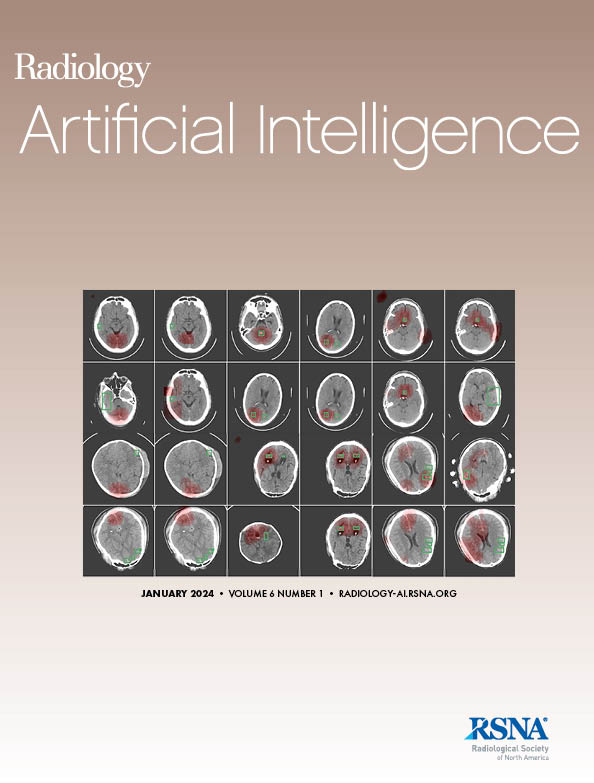Alexander S Giuffrida, Sulaiman Sheriff, Vicki Huang, Brent D Weinberg, Lee A D Cooper, Yuan Liu, Brian J Soher, Michael Treadway, Andrew A Maudsley, Hyunsuk Shim
下载PDF
{"title":"NNFit:一种加速量化高分辨率短回波时间MR光谱数据集的自监督深度学习方法。","authors":"Alexander S Giuffrida, Sulaiman Sheriff, Vicki Huang, Brent D Weinberg, Lee A D Cooper, Yuan Liu, Brian J Soher, Michael Treadway, Andrew A Maudsley, Hyunsuk Shim","doi":"10.1148/ryai.230579","DOIUrl":null,"url":null,"abstract":"<p><p>Purpose To develop and evaluate the performance of NNFit, a self-supervised deep learning method for quantification of high-resolution short-echo-time (TE) echo-planar spectroscopic imaging (EPSI) datasets, with the goal of addressing the computational bottleneck of conventional spectral quantification methods in the clinical workflow. Materials and Methods This retrospective study included 89 short-TE whole-brain EPSI/generalized autocalibrating partial parallel acquisition scans from clinical trials for glioblastoma (trial 1, May 2014-October 2018) and major depressive disorder (trial 2, 2022-2023). The training dataset included 685 000 spectra from 20 participants (60 scans) in trial 1. The testing dataset included 115 000 spectra from five participants (13 scans) in trial 1 and 145 000 spectra from seven participants (16 scans) in trial 2. A comparative analysis was performed between NNFit and a widely used parametric-modeling spectral quantitation method (FITT). Metabolite maps generated by each method were compared using the structural similarity index measure (SSIM) and linear correlation coefficient (<i>R<sup>2</sup></i>). Radiation treatment volumes for glioblastoma based on metabolite maps were compared using the Dice coefficient and a two-tailed <i>t</i> test. Results Mean SSIMs and <i>R</i><sup>2</sup> values for trial 1 test set data were 0.91 and 0.90 for choline, 0.93 and 0.93 for creatine, 0.93 and 0.93 for <i>N</i>-acetylaspartate, 0.80 and 0.72 for myo-inositol, and 0.59 and 0.47 for glutamate plus glutamine. Mean values for trial 2 test set data were 0.95 and 0.95, 0.98 and 0.97, 0.98 and 0.98, 0.92 and 0.92, and 0.79 and 0.81, respectively. The treatment volumes had a mean Dice coefficient of 0.92. The mean processing times were 90.1 seconds for NNFit and 52.9 minutes for FITT. Conclusion A deep learning approach to spectral quantitation offers performance similar to that of conventional quantification methods for EPSI data, but with faster processing at short TE. <b>Keywords:</b> MR Spectroscopy, Neural Networks, Brain/Brain Stem <i>Supplemental material is available for this article</i>. © RSNA, 2025.</p>","PeriodicalId":29787,"journal":{"name":"Radiology-Artificial Intelligence","volume":" ","pages":"e230579"},"PeriodicalIF":13.2000,"publicationDate":"2025-03-01","publicationTypes":"Journal Article","fieldsOfStudy":null,"isOpenAccess":false,"openAccessPdf":"https://www.ncbi.nlm.nih.gov/pmc/articles/PMC11950874/pdf/","citationCount":"0","resultStr":"{\"title\":\"NNFit: A Self-Supervised Deep Learning Method for Accelerated Quantification of High-Resolution Short-Echo-Time MR Spectroscopy Datasets.\",\"authors\":\"Alexander S Giuffrida, Sulaiman Sheriff, Vicki Huang, Brent D Weinberg, Lee A D Cooper, Yuan Liu, Brian J Soher, Michael Treadway, Andrew A Maudsley, Hyunsuk Shim\",\"doi\":\"10.1148/ryai.230579\",\"DOIUrl\":null,\"url\":null,\"abstract\":\"<p><p>Purpose To develop and evaluate the performance of NNFit, a self-supervised deep learning method for quantification of high-resolution short-echo-time (TE) echo-planar spectroscopic imaging (EPSI) datasets, with the goal of addressing the computational bottleneck of conventional spectral quantification methods in the clinical workflow. Materials and Methods This retrospective study included 89 short-TE whole-brain EPSI/generalized autocalibrating partial parallel acquisition scans from clinical trials for glioblastoma (trial 1, May 2014-October 2018) and major depressive disorder (trial 2, 2022-2023). The training dataset included 685 000 spectra from 20 participants (60 scans) in trial 1. The testing dataset included 115 000 spectra from five participants (13 scans) in trial 1 and 145 000 spectra from seven participants (16 scans) in trial 2. A comparative analysis was performed between NNFit and a widely used parametric-modeling spectral quantitation method (FITT). Metabolite maps generated by each method were compared using the structural similarity index measure (SSIM) and linear correlation coefficient (<i>R<sup>2</sup></i>). Radiation treatment volumes for glioblastoma based on metabolite maps were compared using the Dice coefficient and a two-tailed <i>t</i> test. Results Mean SSIMs and <i>R</i><sup>2</sup> values for trial 1 test set data were 0.91 and 0.90 for choline, 0.93 and 0.93 for creatine, 0.93 and 0.93 for <i>N</i>-acetylaspartate, 0.80 and 0.72 for myo-inositol, and 0.59 and 0.47 for glutamate plus glutamine. Mean values for trial 2 test set data were 0.95 and 0.95, 0.98 and 0.97, 0.98 and 0.98, 0.92 and 0.92, and 0.79 and 0.81, respectively. The treatment volumes had a mean Dice coefficient of 0.92. The mean processing times were 90.1 seconds for NNFit and 52.9 minutes for FITT. Conclusion A deep learning approach to spectral quantitation offers performance similar to that of conventional quantification methods for EPSI data, but with faster processing at short TE. <b>Keywords:</b> MR Spectroscopy, Neural Networks, Brain/Brain Stem <i>Supplemental material is available for this article</i>. © RSNA, 2025.</p>\",\"PeriodicalId\":29787,\"journal\":{\"name\":\"Radiology-Artificial Intelligence\",\"volume\":\" \",\"pages\":\"e230579\"},\"PeriodicalIF\":13.2000,\"publicationDate\":\"2025-03-01\",\"publicationTypes\":\"Journal Article\",\"fieldsOfStudy\":null,\"isOpenAccess\":false,\"openAccessPdf\":\"https://www.ncbi.nlm.nih.gov/pmc/articles/PMC11950874/pdf/\",\"citationCount\":\"0\",\"resultStr\":null,\"platform\":\"Semanticscholar\",\"paperid\":null,\"PeriodicalName\":\"Radiology-Artificial Intelligence\",\"FirstCategoryId\":\"1085\",\"ListUrlMain\":\"https://doi.org/10.1148/ryai.230579\",\"RegionNum\":0,\"RegionCategory\":null,\"ArticlePicture\":[],\"TitleCN\":null,\"AbstractTextCN\":null,\"PMCID\":null,\"EPubDate\":\"\",\"PubModel\":\"\",\"JCR\":\"Q1\",\"JCRName\":\"COMPUTER SCIENCE, ARTIFICIAL INTELLIGENCE\",\"Score\":null,\"Total\":0}","platform":"Semanticscholar","paperid":null,"PeriodicalName":"Radiology-Artificial Intelligence","FirstCategoryId":"1085","ListUrlMain":"https://doi.org/10.1148/ryai.230579","RegionNum":0,"RegionCategory":null,"ArticlePicture":[],"TitleCN":null,"AbstractTextCN":null,"PMCID":null,"EPubDate":"","PubModel":"","JCR":"Q1","JCRName":"COMPUTER SCIENCE, ARTIFICIAL INTELLIGENCE","Score":null,"Total":0}
引用次数: 0
引用
批量引用

 求助内容:
求助内容: 应助结果提醒方式:
应助结果提醒方式:


